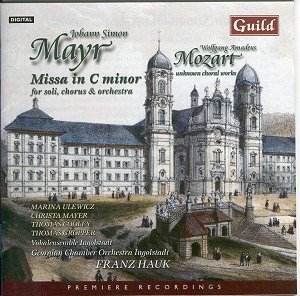 Composer: Johann Simon Mayr
Composer: Johann Simon Mayr
Works: Mass in C minor, Mozart Salve Regina, Quis te-comprehendat, In te Domine speravi
Performers: Marian Ulewicz (soprano), Christa Mayer (alto), Thomas Cooley (tenor), Thomas Gropper (bass), Vokalensemble Ingolstadt, Georgian Chamber Orchestra, Franz Hauk (conductor)
Recording: DDD
Label: Guild GMCD 7231
Johann Simon Mayr, a pivotal yet often overlooked figure in the transition from Classical to Romantic music, composed a significant body of work that includes operas, symphonies, and a wealth of sacred music. Born in 1763 in Mendorf, Mayr’s education under the Jesuits heavily influenced his musical language, reflecting both liturgical solemnity and the theatrical flair of his operatic endeavors. The present recording features Mayr’s Mass in C minor alongside selected motets by Mozart, creating an intriguing juxtaposition of styles and approaches to sacred music.
The Mass opens with a Kyrie that, while sober, reveals a tunefulness that may remind listeners of Beethoven’s early works, particularly the Piano Trio in C minor, Op. 1. This thematic resemblance is not merely a coincidence, as Mayr’s melodic lines exhibit a keen awareness of the broader musical landscape of his time. The quartet singing in the Kyrie is particularly commendable, displaying a blend of precision and warmth that sets a promising tone for the performance. However, this initial impression is soon challenged by the Gloria, which features a catchy yet somewhat trivial tune. The unison singing, while lively, borders on repetitiveness and detracts from the liturgical gravity expected in a mass setting. This tonal shift raises questions about the balance between joyful expression and the sacred context of the work.
Mayr’s style, marked by its Italianate influence, often seems to straddle the line between sacred reverence and the exuberance of comic opera. The Gratias agimus, however, showcases the choir’s virtuosic capabilities, offering moments of genuine beauty that momentarily realign the listener’s expectations. Yet, this raises the conundrum of assessing a composition that oscillates between the sublime and the pedestrian. The Credo, with its unison motif echoing the Gloria, threatens monotony but is occasionally redeemed by passages of striking lyricism that remind us of Mayr’s potential for greatness.
The performance by the Vokalensemble Ingolstadt under Franz Hauk’s direction is technically proficient, with individual soloists demonstrating commendable artistry, particularly in the quartet sections. However, the interpretative choices sometimes lean towards the superficial, failing to adequately convey the depth of the texts. The Mass’s Et Resurrexit, for instance, elicits a whimsical quality that feels jarring in the context of the liturgical narrative, contrasting sharply with the more serious passages. The jolly Agnus Dei further complicates the work’s spiritual integrity, eliciting a sense of dissonance in what should be a moment of reflective solemnity.
Recording quality is notably clear, allowing the intricacies of the orchestral and choral textures to emerge distinctly. The sound engineering captures the nuances of the Georgian Chamber Orchestra, whose playing is spirited yet respectful of the work’s sacred origins. However, one cannot help but feel that the interpretations, while competent, lack the gravitas that more established sacred works demand. Comparisons to other recordings of Mayr’s oeuvre reveal a spectrum of interpretations, with some performances managing to encapsulate the complexity of his musical language more effectively.
The Mozart pieces, though shorter, are executed with a finesse that underscores Mozart’s innate understanding of sacred music. The Salve Regina, in particular, stands as a testament to Mozart’s ability to imbue liturgical music with emotional depth and elegance, contrasting sharply with the more flamboyant tendencies of Mayr’s Mass. While the performances of these motets are polished, they do not reach the heights of Mozart’s most transcendent works.
The recording presents a compelling, if imperfect, exploration of Mayr’s Mass in C minor. It offers glimpses of a composer who, while grappling with the stylistic tensions of his time, occasionally transcends them. The performances are commendable, but the interpretative choices leave one wanting for a deeper engagement with the sacred text. This disc serves as an invitation to further explore Mayr’s contributions to sacred music, though it ultimately underscores the challenges inherent in reconciling the sacred and the secular within his compositions.



